
- Home
- Certification
- Composition
- Denomination
- Fineness
- Type
- Action Figure (61)
- Armor (29)
- Boot (26)
- Carb (11)
- Carburetor (183)
- Complete Carburetor (27)
- Complete Carburettor (33)
- Helmet (21)
- Jacket (17)
- Manifold (14)
- Military -- Aviation (15)
- Model Kit (12)
- Part (12)
- Rc Tank (40)
- Tactical Vest (18)
- Tank (43)
- Throttle Body (40)
- Twin Carburetors (44)
- Twin Carburetors Kit (37)
- Wristwatch (52)
- Other (3179)
- Year
Jewish MILITARY WALL CLOCK Israel AIRFORCE Fighter SQUADRON Emblem IDF ZAHAL
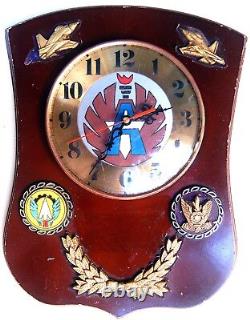
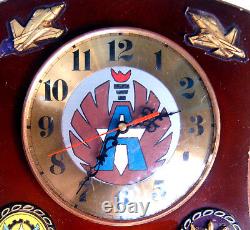
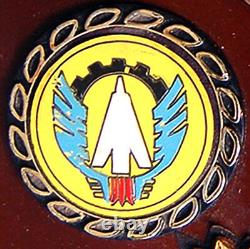
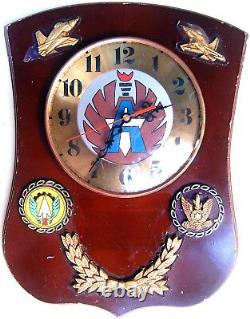
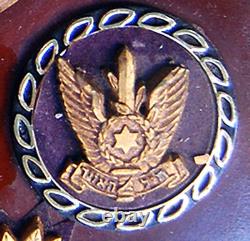
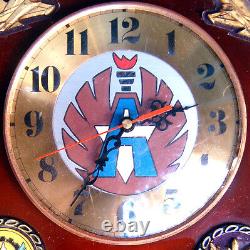
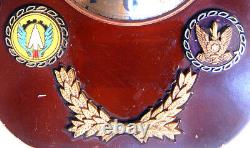
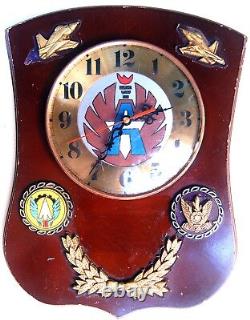


Up for sale is a rare and most interesting ISRAELIANA GEM. It's an original vintage SQUADRON WALL CLOCK, Of an IDF - ZAHAL - IAF ISRAEL AIR FORCE fighters squadron. The large electric CLOCK carries the EMBLEM of the military IDF AIR FORCE BASE & Military AIRPORT - "HATZERIM" which hosts among other facilities fighters squadrons of F-15, F-16, T4-A and BLACK HAWK. In addition to the large clock, The WOODEN BASE, SHILD OF ARMS so to speak carries also a few decorative fighters models, The IAF emblem and the specific squadron sign -emblem which I'm unable to identify.
There are signs for a small written plate below the clock which is missing. The mesurements are around 15" x 11" x 1.5. The clock doesn't work but the standard mechanism at the back is easily acceseable and can be easily replaced. (Pls look at scan for accurate AS IS images). Will be sent inside a protective rigid packaging. Hatzerim Israeli Air Force Base Hebrew:??????? Bsis Heil HaAvir Hatzerim (ICAO: LLHB) is an air base of theIsraeli Air Force in the Negev Desert on the west outskirts of Beersheba, near Kibbutz Hatzerim. The base was constructed during the early 1960s and declared operational on 3 October 1966, the first air base located on a former Royal Air Force base.At Hatzerim is the Israeli Air Force Museum, which opened in 1977 and has allowed public access since June 1991. The IAF Flight Academy has been housed at Hatzerim since April 1966 and the IAF Aerobatic Team is located there as well. Zroa HaAvir VeHahalal, "Air and Space Arm", commonly known as????
Kheil HaAvir, "Air Corps" operates as the aerial warfare branch of the Israel Defense Forces. It was founded on May 28, 1948, shortly after the Israeli Declaration of Independence.
As of May 2012 Aluf Amir Eshel serves as the Air Force Commander. The Israeli Air Force formed on May 28, 1948, using commandeered or donated civilian aircraft and obsolete and surplus World War II combat-aircraft. Eventually, more aircraft were procured, including Boeing B-17s, Bristol Beaufighters, de Havilland Mosquitoes and P-51D Mustangs. The Israeli Air Force played an important part in Operation Kadesh, Israel's part in the 1956 Suez Crisis.
On June 5, 1967, the first day of the Six-Day War, the Israeli Air Force executed Operation Focus, crippling the opposing Arab air forces and attaining air supremacy for the remainder of the war. Shortly after the end of the Six-Day War, Egypt initiated the War of Attrition, and the Israeli Air Force undertook repeated bombings of strategic targets deep within enemy territory. On October 7, 1973, the IAF conducted Operation Tagar against Egyptian air bases of the Egyptian Air Defence Force.Although initially successful, with 10 bases hit, the urgency of the fighting on the Golan heights forced the operations' suspension. Since that war most of Israel's military aircraft have been obtained from the United States. Among these are the F-4 Phantom II, A-4 Skyhawk, F-15 Eagle and F-16 Fighting Falcon.
The Israeli Air Force has also operated a number of domestically produced types such as the IAI Nesher, and later, the more advanced IAI Kfir. On June 7, 1981, eight IAF F-16A fighters covered by six F-15A jets carried out Operation Opera to destroy the Iraqi nuclear facilities at Osiraq. On June 9, 1982, the Israeli Air Force carried out Operation Mole Cricket 19, crippling the Syrian air defence array. The IAF continued to mount attacks on Hezbollah and PLO positions in south Lebanon. On October 1, 1985, In response to a PLOterrorist attack which murdered three Israeli civilians in Cyprus, the Israeli air force carried out Operation Wooden Leg.
The strike involved the bombing of PLO Headquarters in Tunis, by F-15 Eagles. In 1991, the IAF carried out Operation Solomonwhich brought Ethiopian Jews to Israel. In 1993 and 1996, the IAF participated in Operation Accountability and Operation Grapes of Wrath, respectively.It took part in many missions since, including during the 2006 Lebanon War, Operation Cast Lead, Operation Pillar of Cloud and Operation Protective Edge. On September 6, 2007, the Israeli Air Force successfully bombed an alleged Syrian nuclear reactor in Operation Orchard. Aircraft usually carry it painted in six positions - on the top and bottom of each wing, and on each side of the fuselage A low-visibility variant - a blue Star of David without the white circle- also exists, although its use is extremely rare. Squadron markings usually go on the tail fin. [4] The Israeli Air Force formed on May 28, 1948, shortly after Israel declared statehood and found itself under attack.
It consisted of a hodge-podge of commandeered or donated civilian aircraft converted to military use. A variety of obsolete and surplus ex-World War II combat-aircraft were quickly sourced by various means to supplement this fleet.
Creativity and resourcefulness were the early foundations of Israeli military success in the air, rather than technology (which, at the inception of the IAF, was generally inferior to that used by Israel's adversaries). Many[quantify] of the first IAF's pilots in 1948 were foreign volunteers (both Jewish and non-Jewish) and World War II veterans, who wanted to collaborate with Israel's struggle for independence. Israel's new fighter-arm first went into action on May 29, 1948, assisting the efforts to halt the Egyptian advance from Gaza northwards. Four newly arrived Avia S-199s, flown by Lou Lenart, Modi Alon, Ezer Weizman and Eddie Cohen, struck Egyptian forces near Ashdod.
Although damage to the enemy was minimal, two aircraft were lost and Cohen killed, the attack achieved its goal and stopped the Egyptians. The Israeli Air Force scored its first aerial victories on June 3, when Modi Alon, flying Avia D. 112, shot down two Egyptian Air Force DC-3s which had just bombed Tel Aviv. The first dogfight against enemy fighters took place a few days later, on June 8, when Gideon Lichtaman shot down an Egyptian Spitfire. [5] As the war progressed more and more aircraft were procured, including Boeing B-17s, Bristol Beaufighters, de Havilland Mosquitoes and P-51D Mustangs, leading to a shift in the balance of power.
Gloster Meteor Suez Crisis (1956)[edit] The Israeli Air Force played an important part in Operation Kadesh, Israel's part in the 1956 Suez Crisis. At the launch of the operation, on October 29, Israeli P-51D Mustangs severed telephone lines in the Sinai, some using their propellor blades, [6] while 16 IAF DC-3sescorted by fighters dropped Israeli paratroopers behind Egyptian lines at the Mitla Pass and Et-Tur.Six-Day War (1967)[edit] In three hours on the morning of June 5, 1967, the first day of the Six-Day War, the Israeli Air Force executed Operation Focus, crippling the opposing Arab air forces and attaining air supremacy for the remainder of the war. In a surprise attack, the IAF destroyed most of the Egyptian Air Force while its planes were still on the ground. By the end of the day, with surrounding Arab countries also drawn into the fighting, the IAF had mauled the Syrian and Jordanian air forces as well, striking as far as Iraq.
After six days of fighting Israel claimed a total of 452 Arab aircraft destroyed, of which 49 were aerial victories. After the IAF's impressive performance in the Six-Day War, the Lyndon Johnson administration decided to sell F-4 Phantom fighters to Israel in 1968, marking the first sale of American military equipment to Israel. [7] Mirage IIIC at the Israeli Air Force Museum in Hatzerim. A veteran of fighting during the 1960s and 1970s, the aircraft bears 13 victory markings War of Attrition[edit] Shortly after the end of the Six-Day War, Egypt initiated the War of Attrition, hoping to prevent Israel from consolidating its hold over the lands captured in 1967.Israel's goal in the fighting was to exact heavy losses on the opposing side, in order to facilitate a ceasefire. The Israeli Air Force consequently undertook repeated bombings of strategic targets deep within enemy territory and repeatedly challenged Arab air forces for aerial supremacy, all the while supporting operations by Israel's ground and naval forces.
In late 1969 the Soviet Union began to deploy fighter aircraft units and surface-to-air missile units to Egypt. The Soviet surface-to-air missile units soon joined their Egyptian allies in direct confrontations with Israeli aircraft. Soviet fighters conducted patrols but Israeli pilots were ordered not to engage them.
However, on July 30, 1970, the tension peaked: An IAF ambush resulted in a large scale air brawl between IAF planes and MiGs flown by Soviet pilots-five MiGs were shot down, while the IAF suffered no losses. Fear of further escalation and superpower involvement brought the war to a conclusion. By the end of August 1970, the Israeli Air Force had claimed 111 aerial kills while reporting losing only four aircraft to Arab fighters.
Egyptian and Soviet forces claimed to shoot down approximately 20 Israeli Air Force planes with surface-to-air missile and anti-aircraft artillery units. Yom Kippur War (1973)[edit] A-4N Skyhawk On October 6, 1973, with war imminent, the IAF began preparing for a pre-emptive strike against Egyptian and Syrian airfields and anti-aircraft positions. The Israeli government, however, decided against pre-emption. [8] IAF aircraft were therefore in the process of re-armament to the air-to-air role when Yom Kippur War hostilities began at 14:00. [9] The next morning begun with Operation Tagar, a SEAD offensive against Egyptian air defences, beginning with strikes against Egyptian air bases. Tagar, however, was quickly discontinued when the dire situation on the Golan Heights became apparent. IAF efforts were redirected north, where the ill-fated Operation Doogman 5 was carried out. Flying with outdated intelligence and no electronic screening against mobile SAM batteries and heavy flak, 6 IAF Phantoms were lost. [10] The sustained campaign required to defeat enemy air defences was abandoned in the face of Egyptian and Syrian advances and the IAF was forced to operate under the SAM threat. Nevertheless, the close air support it provided allowed Israeli troops on the ground to stem the tide and eventually go on the offensive, first in the north and later in the south. [11][12] After the failure of the Israeli counter-offensive in the Sinai on October 8, the southern front remained relatively static and the IAF focused its attention on the Syrian front. [12] While A-4 Skyhawks provided much needed support to troops on the ground, at the cost of 31 aircraft by the end of fourth day of the war, [13]IAF Phantoms repeatedly struck Syrian air fields.[14] Following Syrian FROG-7 strikes on military and civilian targets in northern Israel, the IAF also initiated a campaign to destroy the infrastructure on which Syria's war-making capacity depended, targeting strategic targets in Syria such as its oil industry and electricity generating system. [15] By October 13 the Syrians had been pushed back and beyond their initial lines, Damascus had come within range of Israeli artillery and an Iraqi armored brigade, the vanguard of its expeditionary force, was destroyed. [16] 201 Squadron IAF F-4E Phantom II with 3 kill markings On October 14 the Egyptian army launched an offensive along the entire front, but was repulsed by the IDF. Israel followed on this success by attacking at the seam between the 2nd and 3rd Egyptian armies and crossing the Suez Canal into Egypt. Israeli forces fanned north and south, destroying Egyptian rear units and punching holes through its air defence array.
This allowed the IAF the freedom of action it was previously denied and renewed attacks led to the collapse of the Egyptian Air Defence Force. This prompted increased diplomatic activity to resolve the war, coupled with increased activity by the Egyptian Air Force. From about October 18 to the end of the war, intensive air battles took place between Israeli and Egyptian aircraft. [12][17] Official Israeli Air Force losses of the Yom Kippur War number at 102 aircraft, including 32 F-4 Phantoms, 53 A-4 Skyhawks, 11 Dassault Mirages, and 6 IAI Sa'ars, although other accounts suggest as many as 128 Israeli aircraft were lost. [18][19] 91 air force personnel, of which 53 were airmen, were killed. 172 Egyptian aircraft were shot down in air-to-air combat, for a loss of between 5 and 21 for the Israelis (on all fronts). [19][20] No official numbers were released on the Arab side, though total Egyptian losses were between 235 and 242 aircraft, while Syria lost between 135 and 179. The Israeli Air Force has also operated a number of domestically produced types such as the IAI Nesher, and later, the more advanced IAI Kfir, which were unauthorised derivatives of the French Dassault Mirage 5.The Kfir was adapted to utilize a more powerful U. Engine, produced under license in Israel. On July 4, 1976, four Israeli C-130 Hercules transport aircraft secretly flew to Entebbe Airport for a rescue operation. In March 1978, the Israeli Air Force participated in Operation Litani. Among the pilots that took part in the attack was Ilan Ramon, later Israel's first astronaut.
1982 Lebanon War and aftermath[edit] Israeli Air Force F-16A Netz #107with 7.5 kill markings, including one forOperation Opera, a world record for a single F-16 Prior to the 1982 Lebanon War, Syria, with the help of the Soviet Union, had built up an overlapping network of surface-to-air missiles inLebanon's Beqaa Valley. In subsequent aerial battles against the Syrian Air Force, the IAF managed to shoot down 86 Syrian aircraft without losing a single fighter plane in an air-to-air combat. IAF AH-1 Cobra helicopter gunships destroyed dozens of Syrian armored fighting vehicles and other ground targets, including some T-72 main battle tanks. For many years after the war's official end, and throughout Israeli presence in Lebanon, the IAF continued to mount attacks on Hezbollahand PLO positions in south Lebanon.
On October 1, 1985, In response to a PLO terrorist attack which murdered three Israeli civilians inCyprus, the Israeli air force carried out Operation Wooden Leg. This was the longest combat mission ever undertaken by the IAF, a stretch of 2,300 kilometers, involving in-flight refueling by an IAF Boeing 707. As a result, PLO headquarters and barracks were either destroyed or damaged. 1990s and beyond[edit] 69 Squadron F-15I Ra'ams at Red Flag 04-3 Israeli AH-64D Saraph during an exercise with the Hellenic Air Force. Israeli Air Force F-15s over Auschwitz. September 3, 2003 Many of the IAF's electronics and weapons systems are developed and built in Israel by Israel Military Industries, Israel Aerospace Industries, Elbit, and others.Since the 1990s, the IAF has upgraded most of its aircraft with advanced Israeli-made systems, improving their performances. In 1990 the IAF began receiving the AH-64 Apache helicopter gunship and started equipping its aircraft with theRafael Python 4, Popeye, and Derby missiles. During the first Gulf War of 1991, Israel was attacked by Iraqi Scud missiles. Israeli Air Force pilots were on constant stand-by in their cockpits throughout the conflict, ready to fly to Iraq to retaliate. Diplomatic pressure as well as denial of IFF transponder codes from the United States, however, kept the IAF grounded while Coalition air assets and Patriot missile batteries supplied by the US and the Netherlands sought to deal with the Scuds.
In 1991, the IAF carried out Operation Solomon which brought Ethiopian Jews to Israel. In 1993 and 1996, the IAF participated inOperation Accountability and Operation Grapes of Wrath, respectively. The first of 102 F-16I Sufas arrived in April 2004 joining an F-16 fleet that had already been the largest outside the US Air Force.In 2005 the Israeli Air Force received modified Gulfstream V jets ("Nachshon"), equipped with advanced intelligence systems made by Israel Military Industries. The Israeli Air Force took an extensive part in IDF operations during the al-Aqsa Intifada, including the controversial targeted killings of Palestinian militant leaders, most notably Salah Shakhade, Ahmed Yassin and Abed al-Aziz Rantissi.
While this policy was criticized due to the collateral damage caused in certain instances, Israel claims it is vital in its fight against terrorism and that IAF pilots do whatever they can to avoid civilian casualties, including aborting strikes. In 2007, Israel achieved a civilian casualty ratio of 1:30, or one civilian casualty for every thirty combatant casualties, in its airstrikes on militants in the Palestinian territories. [22] Alan Dershowitz noted that "No army in history has ever had a better ratio of combatants to civilians killed in a comparable setting". [23] On October 5, 2003, the Israeli Air Force attacked an alleged Palestinian militant training camp in Ain es Saheb, Syria. IAF bombs a Hezbollah rocket launcher 2006 Lebanon War[edit] The IAF played a critical role in the 2006 Lebanon War.IAF strikes-mainly, though not exclusively, insouthern Lebanon-were aimed at stopping rocket launches by Hezbollah's militia targeting Israeli towns. The IAF flew more than 12,000 combat missions during this war.
The most notable, taking place during the second day of the war, resulted in the IAF destroying 59 -supplied medium- and long-rangemissile launchers in just 34 minutes. [24] Widespread condemnation followed the July 30 IAF airstrike on a building suspected to be a militant hideout near the village of Qana, in which 28 civilians were killed.
Hezbollah shot down an IAF CH-53 Yas'urhelicopter on the last day of the war, killing five crew members. [25][26] Israeli aircraft also shot down three of Hezbollah's -made[27] aerialdrones during the conflict. [28] Activities 2007-present[edit] On September 6, 2007, the Israeli Air Force successfully bombed an alleged Syrian nuclear reactor in Operation Orchard. It had a principal role in destroying Hamas targets.The IAF also killed several senior Hamas commanders including Said Seyam, [29] Nizar Rayan, [30] Tawfik Jaber, [31] and Abu Zakaria al-Jamal. [32] According to a CBS news report, in January 2009 Israeli planes struck a convoy of trucks in Sudan headed for Egypt and carrying weapons apparently meant for the Gaza Strip.
Seventeen trucks were bombed and thirty-nine smugglers were killed in the strike. [33] On April 5, 2011, a car driving from Port Sudan Airport to Port Sudan was destroyed by a missile. Both passengers were killed and one of the passengers may have been a senior military commander of Hamas. The Sudanese Foreign Minister blamed the attack on Israel.
[34]Sudanese newspapers reported that Israeli aircraft attacked Gaza-bound arms convoys again in late 2011. [35] On October 24, 2012, Sudan claimed that Israel had bombed a munitions factory south of Khartoum. [36][37][38] The Israeli Air Force also operates surface-to-air missile and anti-aircraft artillery units. These have all participated in the wars and have shot down a number of Arab aircraft. Since 1990 their major role has been interception of surface-to-surface missiles and rockets fired into Israel. In 2011 the IAF began operating the'Iron Dome' anti-rocket missile system, which within a year had successfully intercepted and destroyed 93 rockets fired at Israeli towns from Gaza.[39] In November 2012, the IAF participated in Operation Pillar of Defense, during which, according to the IDF Spokesperson, Israeli forces targeted more than 1,500 military sites in Gaza Strip, including rocket launching pads, smuggling tunnels, command centers, and weapons manufacturing and storage buildings. Many of these attacks were carried out by the Air Force.
[40] On January 30, 2013, Israeli aircraft allegedly struck a Syrian convoy transporting weapons to Hezbollah. [41] Other sources stated the targeted site was a military research centerin Jamraya responsible for developing biological and chemical weapons. [42] Two additional air strikes reportedly took place on May 3 and 5, 2013. Both targeted long-ranged weapons in transit through Syria from to Hezbollah in Lebanon.
[43][44] According to anonymous U. Officials, Israel launched another airstrike on 5 July. [45] Israel is believed to have carried out another raid on October 30, 2013. The attack happened at an air defense site in Snawbar, 10 miles south of Latakia.
[46] Syrian opposition sources, as well as Lebanese sources, reported that another strike happened in Latakia on January 26, 2014. The target was allegedly S-300 missiles. [47] It was reported that Israeli aircraft carried out two airstrikes against Hezbollah facilities in Lebanon near the border with Syria on February 24, 2014, killing several militants. The Syrian Observatory for Human Rights claimed the attack targeted a Hezbollah missile base. [48] Between July 8 and August 5, 2014, the IAF participated in Operation Protective Edge, during which, according to the IDF Spokesperson, Israeli forces targeted 4,762 terror sites across the Gaza Strip, including rocket launching facilities, command and control centers, military administration facilities, weapons storage and manufacturing facilities, and training and military compounds.[49] On 23 September 2014, a Syrian Air Force Su-24 was shot down by an IAF MIM-104 Patriot Air Defense battery, after allegedly crossing the Syrian-Israeli ceasefire line during a ground attack mission against Syrian opposition forces. [50] On December 7, 2014, Israeli jets allegedly bombed areas near Damascus international airport and in the town of Dimas, near the border with Lebanon.
According to foreign reports the attack targeted a warehouse of advanced S-300 missiles, which were en route from Syria to Hezbollah in Lebanon. [51] On 18 January 2015, Israeli helicopters attacked a Hezbollah's convoy in the Syrian-controlled of Golan Heights, killing six prominent members of Hezbollah and six IRGCcommanders, including a General. [52][53] On 25 April 2015, a series of attacks attributed to the Israeli Air Force were made in the al-Qalamoun region of Syria against Hezbollah camps and weapons convoys in two brigade bases. [54] On 29 July 2015, Israeli airplanes reportedly struck a vehicle located in a Druse village in southwestern Syria, killing Hezbollah men and a pro-Assad militiaman.
[55] A second airstrike targeted a military base along the Syrian-Lebanese border belonging to a pro-Syrian Palestinian faction. [56] It was reported that Samir Kuntar was among those killed.[57] On 20 and 21 August 2015, after four rockets hit the Golan Heights and Upper Galilee, Israel launched airstrikes in Syria, killing several militants. [58] According to Syrian media, on October 31, 2015, Israeli aircraft attacked numerous Hezbollah targets in southern Syria, close to the border with Lebanon in the Qalamoun Mountains region.
Estimated targets included a weapons convoy destined for Hezbollah. [59] It was reported another Israeli airstrike near Damascus airport on November 11[60]that targeted Hezbollah weapons warehouses.
[61] The Syrian opposition reported an Israeli airstrike in the Qualamoun area of the Syria-Lebanon border on 23 November 2015. According to these sources, the strike killed 13 Syrian troops and Hezbollah fighters, and left dozens wounded, including four seriously. The Qualamoun region has been a major transit point for Hezbollah fighters and other logistical equipment to and from Syria. [62] According to Syrian sources, Israeli aircraft attacked again Syrian army and Hezbollah targets in the area around Qalamoun on November 28, causing dead and wounded among Hezbollah fighters. [63] Organization[edit] See also: List of Israeli Air Force aircraft squadrons [show]Order of Battle Israeli Air Force air bases UH-60 Blackhawk landing in the desert An AH-1 Cobra, which the Israelis call AH-1 Tzefa, Hebrew:????
[77] Transport / Utility aircraft Bell Boeing V-22 Osprey United States multipurpose tiltrotor MV-22B Block C 6 In negotiations. [78] Helicopters Sikorsky CH-53K King Stallion United States heavy transport? [79] Sikorsky SH-60 Seahawk United States maritime patrol? 10 From the US Navy surplus[80] Historic[edit] Main article: List of aircraft of the Israeli Air Force Munitions and space systems[edit] Main article: List of Israeli Air Force Munitions Pilot selection and training[edit] IAF Pilots sit atop an F-16D Barak Main article: Israeli Air Force flight academy Thirty nine Israeli pilots have been credited with ace status, having shot down at least 5 enemy aircraft.
Of these, 10 have shot down at least eight jet planes. The top ranking Israeli ace is Colonel Giora Epstein, who shot down seventeen enemy planes. Epstein holds the world record for jet aircraft shot down, and the most aircraft of any type shot down since the Korean War. Although women had served as pilots during the Israeli War of Independence and a few years thereafter, the Israeli Defence Forces had until 1995 denied women the opportunity to become pilots.
In 1995, civilian pilot and aeronautical engineer Alice Miller successfully petitioned the Israel High Court of Justice to take the Israeli Air Force pilot training exams, after being rejected on grounds of gender. Though president Ezer Weizman, a former IAF commander, told Miller that she'd be better off staying home and darning socks, the court in 1996 eventually ruled that the IAF could not exclude qualified women from pilot training. Even though Miller would not pass the exams, the ruling was a watershed, opening doors for women in new IDF roles. After the prohibition had been lifted, the first female graduate was F-16 navigator "Shari" in 1998, followed three years later by Roni Zuckerman, the first female jet fighter pilot in IAF history. [81][82] Ranks[edit] IAF ranks are identical to other Israel Defense Forces ranks except for the use of silver against a dark blue background. The service's most senior-ranking active officer is the air force commander, which is the billet of a major general (aluf), and reports directly to the IDF Chief of Staff. Officers[edit] NATO Code OF-10 OF-9 OF-8 OF-7 OF-6 OF-5 OF-4 OF-3 OF-2 OF-1 OF(D) Student Officer Israel No Equivalent No Equivalent No Equivalent No Equivalent Rav aluf "Chief General" Aluf "General" Tat aluf "Subordinate General" Aluf mishne "Junior General" Sgan aluf "Deputy General" Rav seren "Chief Captain / Commander" Seren "Captain / Commander" Segen "Deputy" Segen mishne "Junior Deputy" USA General of the Air Force General Lieutenant General Major General Brigadier General Colonel Lieutenant Colonel Major Captain First Lieutenant Second Lieutenant Officer Candidate Officer Cadet List of IAF commanders[edit] Amir Eshel, the current IAF commander Yisrael Amir (May 1948 - July 1948) Aharon Remez (July 1948 - December 1950) Shlomo Shamir (December 1950 - August 1951) Haim Laskov (August 1951 - May 1953) Dan Tolkovsky (May 1953 - July 1958) Ezer Weizman (July 1958 - April 1966) Mordechai Hod (April 1966 - May 1973) Binyamin Peled (May 1973 - October 1977) David Ivri (October 1977 - December 1982) Amos Lapidot (December 1982 - September 1987) Avihu Ben-Nun (September 1987 - January 1992) Herzl Bodinger (January 1992 - July 1996) Eitan Ben Eliyahu (July 1996 - April 2000) Dan Halutz (April 2000 - April 2004) Elyezer Shkedy (April 2004 - May 2008) Ido Nehoshtan (May 2008 - May 2012) Amir Eshel (May 2012 -) See also[edit] List of flying aces in Arab-Israeli wars Post-World War II air-to-air combat losses Israeli Air Defense Network Nuclear weapons and Israel Talpiot program. This item is in the category "Collectibles\Religion & Spirituality\Judaism\Images". The seller is "judaica-bookstore" and is located in this country: IL. This item can be shipped worldwide.
- Country/Region of Manufacture: Israel
- Religion: Judaism

